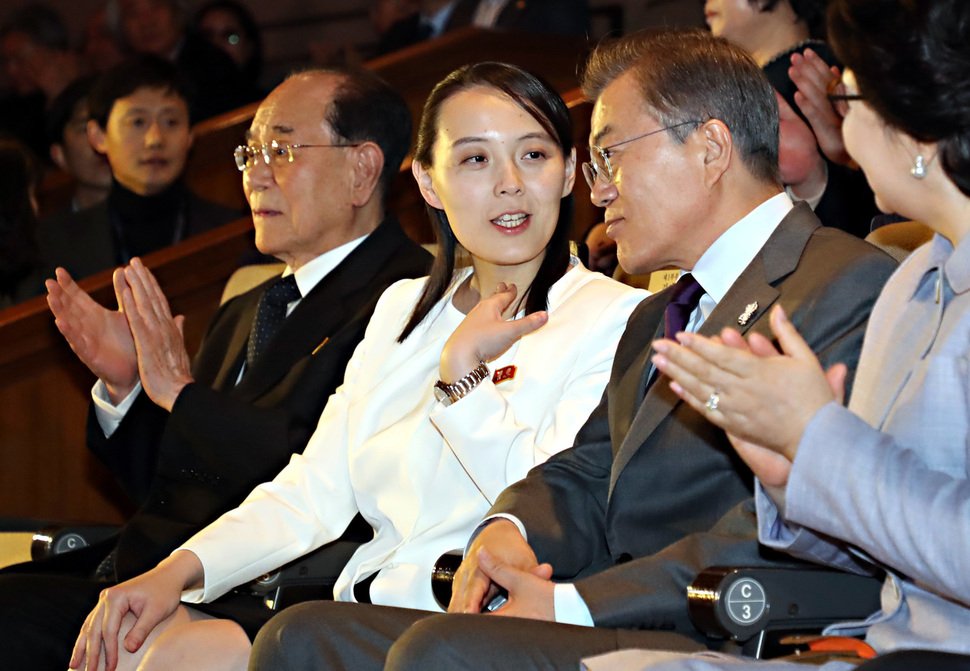 |
|
Kim Yo-jong, the first vice director of the central committee of the North Korean Workers‘ Party (KWP), speaks to President Moon Jae-in during a performance of the Samjiyon Orchestra at the National Theatre in Seoul on Feb. 11. On the far left is Kim Yong-nam, the president of the Presidium of the North Korean Supreme People‘s Assembly. (provided by Blue House)
|
“South and North should work together to turn the sparks of this meeting into a torch,” says President Moon
The proposal for a “third inter-Korean summit” that North Korean leader Kim Jong-un had his younger sister Kim Yo-jong, first vice director of the central committee of the North Korean Workers' Party (KWP), deliver to South Korean President Moon Jae-in is a striking change that would have been unimaginable just 40 days ago. “The fact that we met is very important. South and North Korea should work together to turn the sparks of this meeting into a torch,” Moon said to Kim Yong-nam, the president of the Presidium of the North Korean Supreme People's Assembly, before the beginning of a performance by the Samjiyon musical performance group that was held at the Haeoreum Theater at the National Theater of Korea on Nam Mountain in Seoul on the afternoon of Feb. 11. Moon was responding to the following remark by Kim Yong-nam: “Since you created the opportunity for us to meet frequently and exchange our opinions, I return home with the hope of seeing you again.” During a meeting at the Blue House on Feb. 10, Kim Yo-jong delivered a personal letter from Kim Jong-un to Moon and conveyed a verbal invitation to visit Pyongyang, to which Moon responded by saying, “Let’s create the conditions to make that happen.” “President Moon thinks that quickly holding dialogue between North Korea and the US is absolutely necessary for developing inter-Korean relations. He urged the North to be proactive about engaging in dialogue with the US,” said Kim Eui-kyum, spokesperson for the Blue House. The balmy wind that is blowing on the Korean Peninsula during the Pyeongchang Winter Olympics is the perfect chance to thaw inter-Korean relations, which have been frozen solid during the nine years of the past two administrations, and ultimately to reach a solution to the North Korean nuclear issue. Considering that Moon has declared that he is in the “driver’s seat” on the Korean Peninsula, his driving skill is about to be put to the test as he attempts to use this balmy wind as an impetus to speed down the road toward peace. If Moon proves up to the task, some experts think that the inter-Korean summit could even take place in June, around the 18th anniversary of the first inter-Korean summit (June 15, 2000) or in August, around National Liberation Day on Aug. 15, which is a major holiday in both South and North Korea. Until then, Moon is likely to focus on creating the “conditions” under which he can sit down with Kim Jong-un and get meaningful results. The key is to set the mood for dialogue between the US and North Korea. “The two axles of inter-Korean dialogue and North Korea-US dialogue have to turn for the cart to move. That’s what President Moon was getting at when he told [Kim Yo-jong and the others] about the importance of North Korea-US dialogue,” said a senior official at the Blue House. “The South Korean government has to get North Korea to take a flexible attitude on denuclearization and the US to move away from its strict focus on pressure against North Korea and open up to the possibility of dialogue with the North,” said former Unification Minister Lee Jong-seok.
 |
|
President Moon Jae-in (left) watches the first game of the unified Korean women’s hockey team with IOC President Thomas Bach, Kim Yong-nam, the president of the Presidium of the North Korean Supreme People‘s Assembly, and Kim Yo-jong, the first vice director of the central committee of the North Korean Workers‘ Party (KWP) at the Gangneung Ice Arena on Feb. 10. (by Park Jong-shik, staff photographer)
|







